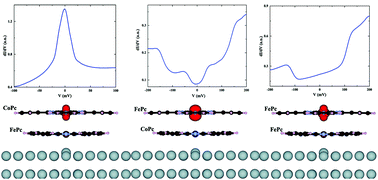Manipulation of spin and magnetic anisotropy in bilayer magnetic molecular junctions†
Abstract
Understanding the role of spin-environment interactions in the electron transport properties of magnetic quantum systems is central to the rational design of spintronics devices. Herein, two emergent phenomena arising from such interactions, namely, the Kondo effect and magnetic anisotropy, are investigated theoretically in bilayer transition metal phthalocyanine (TMPc) (TM = Co, Fe) on a Pb(111) substrate by combining the density functional theory (DFT) and hierarchical equations of motion (HEOM) approaches. The calculation results indicate that the Kondo temperature TK and magnetic anisotropy energy in TMPc/TMPc/Pb(111) junctions can be actively tuned through the modification of the TM atom at the molecular center. In particular, the CoPc/FePc/Pb(111) composite exhibits a similar spin-1/2 Kondo effect as the CoPc/CoPc/Pb(111) composite reported previously in experiments, but TK is one order of magnitude larger with the modification of the intermediate decoupling layer from CoPc to FePc. Moreover, the magnetic anisotropy energy of the composite systems can also be switched from the easy axis of D = −12.6 meV, E = 1.56 meV in FePc/CoPc/Pb(111) to D = −11.2 meV, E = 0.0 meV in FePc/FePc/Pb(111) by changing the intermediate layer. We attribute these intriguing tunabilities to the different spin-electron coupling and symmetry of the ligand field provided by the intermediate layer. These findings demonstrate the importance of the decoupling layer for the magnetic properties of adsorbates and offer a promising strategy for the design of spintronics.



 Please wait while we load your content...
Please wait while we load your content...